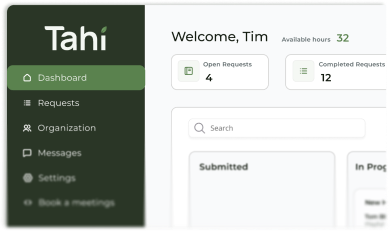Web Accessibility
Web accessibility is the practice of designing and building websites that everyone, including people with disabilities, can use and interact with effectively.
What does web accessibility actually mean for a business website?
For a business, web accessibility means creating an online experience that is open to everyone, regardless of their physical or cognitive abilities. Think of it like adding a ramp to a physical shop. It’s not just for wheelchair users, it also helps parents with prams and people with temporary injuries. Similarly, an accessible website doesn't just benefit people with permanent disabilities, it improves the overall user experience (UX) for all visitors.
Practically, this means your website can be used by people who might be blind and use screen readers, have motor impairments and rely on keyboard navigation, or have hearing impairments and need captions for videos. Beyond being the right thing to do, it expands your potential audience, enhances your brand reputation as an inclusive business, and can even give your SEO a healthy boost, as many accessibility best practices align with what search engines look for.
How can I make my Webflow website accessible for people with disabilities?
Webflow is a powerful platform with great built-in features to help build accessible websites. The key is to be intentional about it from the start. In Figma, before any development begins, we check things like colour contrast to ensure text is readable for people with low vision. This simple step saves a lot of time later on.
During the Webflow build, we focus on several key areas. We use correct semantic HTML so screen readers can understand the page structure. We ensure all images have descriptive alt text, so visually impaired users know what the image conveys. We also make sure the entire site can be navigated using only a keyboard, which is crucial for users with motor disabilities. Webflow's built-in Audit panel is a fantastic tool for catching common issues, helping us ensure everything from links to form fields is set up correctly.
What are the WCAG standards and do they apply to businesses in Australia and New Zealand?
The Web Content Accessibility Guidelines, or WCAG, are the globally recognised standards for web accessibility. They are broken down into three levels of conformance. A, AA, and AAA. Level A is the minimum, while Level AA is the generally accepted standard that most businesses and organisations aim for. Level AAA is the highest standard, often reserved for specialised services.
In both New Zealand and Australia, government websites are required to meet the WCAG 2.1 Level AA standard. While it's not yet strictly mandated by law for all private businesses, it is considered best practice. The legal landscape is evolving, and businesses are increasingly facing legal challenges under disability discrimination laws if their websites are not accessible. More importantly, it's about creating an equitable experience for the one in four Kiwis and one in six Australians who live with a disability.
Does building an accessible website cost more than a standard one?
This is a common question, and the honest answer is it depends on when you prioritise it. If accessibility is considered from the very beginning of the design and development process, the additional cost is minimal. It simply becomes part of a quality workflow, like making a site responsive for mobile devices. It’s a standard part of doing the job well.
Where costs can increase is when an existing, inaccessible website needs to be retrofitted. Fixing deep-rooted structural issues can be complex and time-consuming. This is why we believe that investing in a quality build from the start saves money and headaches in the long run. Building it right the first time is always more efficient than fixing it later.
How can Tahi Studio help ensure my website is accessible?
At Tahi Studio, we believe accessibility is a core part of good design, not an optional extra. It’s woven into our process from the very first design concepts in Figma to the final touches in Webflow. We don’t see it as a box-ticking exercise but as a fundamental aspect of building a high-quality, effective, and inclusive website for your business.
We build every website with WCAG 2.1 AA standards as our benchmark, ensuring your digital front door is open to as many people as possible. If you're unsure how your current website measures up, we can help. A good first step is our free site audit, where we can identify any critical accessibility issues and give you a clear path forward.






